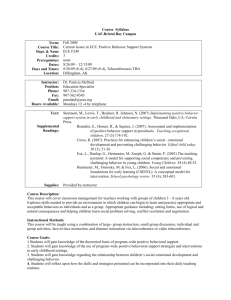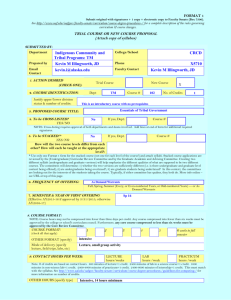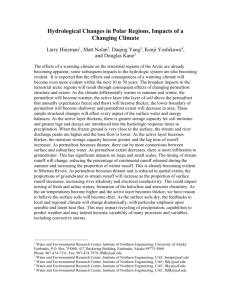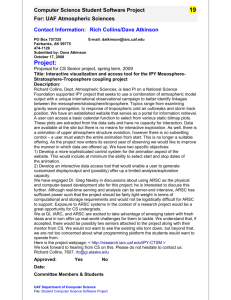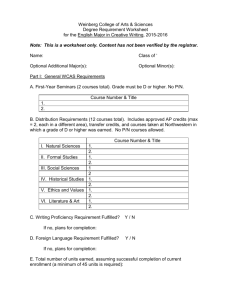November 2013 - University of Alaska Fairbanks
advertisement
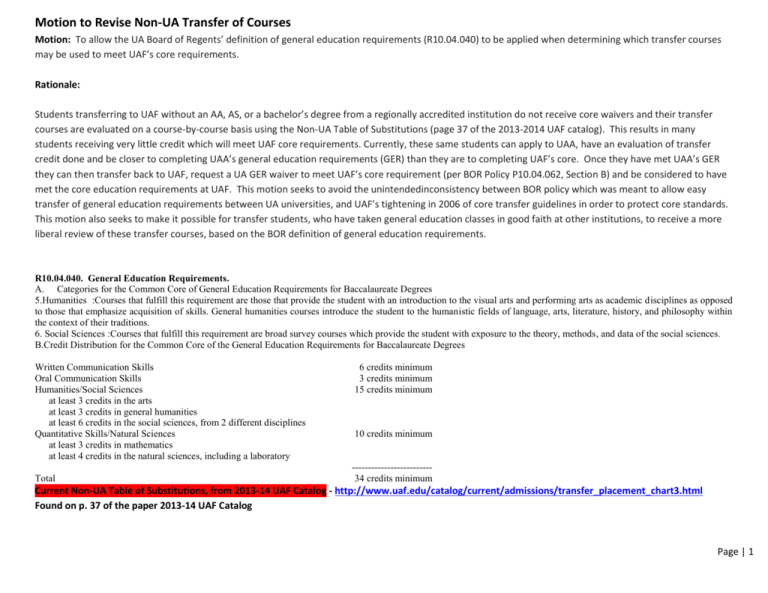
Motion to Revise Non-UA Transfer of Courses Motion: To allow the UA Board of Regents’ definition of general education requirements (R10.04.040) to be applied when determining which transfer courses may be used to meet UAF’s core requirements. Rationale: Students transferring to UAF without an AA, AS, or a bachelor’s degree from a regionally accredited institution do not receive core waivers and their transfer courses are evaluated on a course-by-course basis using the Non-UA Table of Substitutions (page 37 of the 2013-2014 UAF catalog). This results in many students receiving very little credit which will meet UAF core requirements. Currently, these same students can apply to UAA, have an evaluation of transfer credit done and be closer to completing UAA’s general education requirements (GER) than they are to completing UAF’s core. Once they have met UAA’s GER they can then transfer back to UAF, request a UA GER waiver to meet UAF’s core requirement (per BOR Policy P10.04.062, Section B) and be considered to have met the core education requirements at UAF. This motion seeks to avoid the unintendedinconsistency between BOR policy which was meant to allow easy transfer of general education requirements between UA universities, and UAF’s tightening in 2006 of core transfer guidelines in order to protect core standards. This motion also seeks to make it possible for transfer students, who have taken general education classes in good faith at other institutions, to receive a more liberal review of these transfer courses, based on the BOR definition of general education requirements. R10.04.040. General Education Requirements. A. Categories for the Common Core of General Education Requirements for Baccalaureate Degrees 5.Humanities :Courses that fulfill this requirement are those that provide the student with an introduction to the visual arts and performing arts as academic disciplines as opposed to those that emphasize acquisition of skills. General humanities courses introduce the student to the humanistic fields of language, arts, literature, history, and philosophy within the context of their traditions. 6. Social Sciences :Courses that fulfill this requirement are broad survey courses which provide the student with exposure to the theory, methods, and data of the social sciences. B.Credit Distribution for the Common Core of the General Education Requirements for Baccalaureate Degrees Written Communication Skills Oral Communication Skills Humanities/Social Sciences at least 3 credits in the arts at least 3 credits in general humanities at least 6 credits in the social sciences, from 2 different disciplines Quantitative Skills/Natural Sciences at least 3 credits in mathematics at least 4 credits in the natural sciences, including a laboratory Total 6 credits minimum 3 credits minimum 15 credits minimum 10 credits minimum ------------------------34 credits minimum Current Non-UA Table of Substitutions, from 2013-14 UAF Catalog - http://www.uaf.edu/catalog/current/admissions/transfer_placement_chart3.html Found on p. 37 of the paper 2013-14 UAF Catalog Page | 1 PROPOSED REVISION to Non-UA Table of Substitutions NOTE: HIST F100X, ECON/PS F100X, ANTH/SOC F100X fall into the category of Social Sciences under BOR definition of General Education Requirements ART/MUS/THR F200X fall into the category of the Arts under BOR definition of General Education Requirements ENGL/FL F200X fall into the category of the Humanities under BOR definition of General Education Requirements Page | 2 TABLE OF SUBSTITUTIONS: NON-UA INSTITUTIONS This table describes courses accepted by transfer to UAF, from institutions outside the University of Alaska system, which may substitute for UAF's core curriculum. Students transferring from either UAA or UAS should consult UA System 2012 - 2013 Table of Substitutions, or visit www.uaf.edu/admissions/undergrad/transfer/. Core Curriculum Courses Transfer Courses MATH F107X--Functions for Calculus or MATH F103X--Concepts and Contemporary Applications of Mathematics a 100-level or above mathematics course having a prerequisite of at least two years of high school algebra MATH F200X, F201X, F202X, F262X, F272X, STAT F200X a calculus or statistics course at the 100-level or above ENGL F111X--Intro to Academic Writing the required first semester composition course at the 100-level (must be basic freshman composition and not developmental) ENGL F211X--Academic Writing About Literature OR ENGL F213X-Academic Writing About Soc& Nat Sciences the second half of the introductory composition series at the 100-level or above COMM F131X--Fundamentals of Oral Communication Group Context OR COMM F141X--Fundamentals of Oral Communication Public Context a 100-level or above performance course in fundamentals of speech communication, public speaking or small group communication Natural Sciences-8 credits courses in basic natural sciences (biology, chemistry, earth sciences, physics) with labs, at the 100-level or above. Non-lab courses are transferable only as a second natural science course. To fulfill core requirements, a transfer student must complete two lab coursesor two labs. Transfer of credit for courses in a natural science other than those listed requires approval of the dean of the College of Natural Science and Mathematics. Perspectives on the Human Condition HIST F100X--Modern World History ECON/PS F100X--Political Economy ANTH/SOC F100X—Individual, Society and Culture A course in each of three different social sciences ENGL/FL F200X--World Literatures A course in the humanities ART/MUS/THR F200X, HUMS F201X, ANS F202X--Aesthetic Appreciation A course in the arts BA F323X, COMM F300X, JUST F300X, NRM F303X, PHIL F322X, PS F300X--Ethics (Values and Choices) an upper-division course in ethics, or, with approval of the philosophy department, a lowerdivision course in ethics Library and Information Research (0-1 credit) a 100-level library skills course Foreign Language (may be substituted for 6 credits of Perspectives on the Human Condition) two semester-length courses in a single Alaska Native language or other non-English language, or three semester-length courses (9 credits) in American Sign Language at the university level Page | 3

